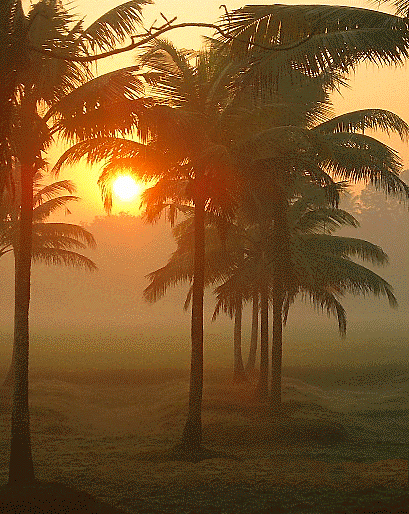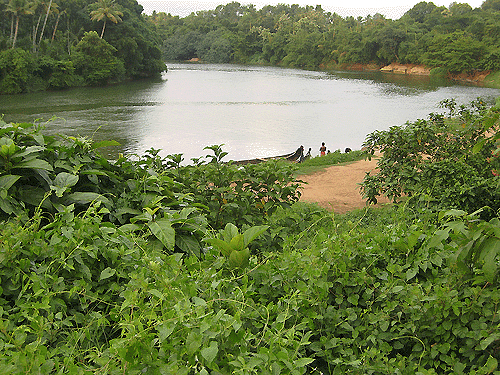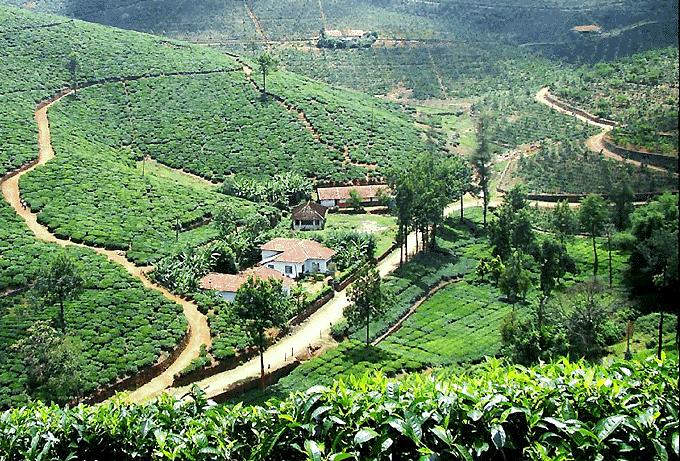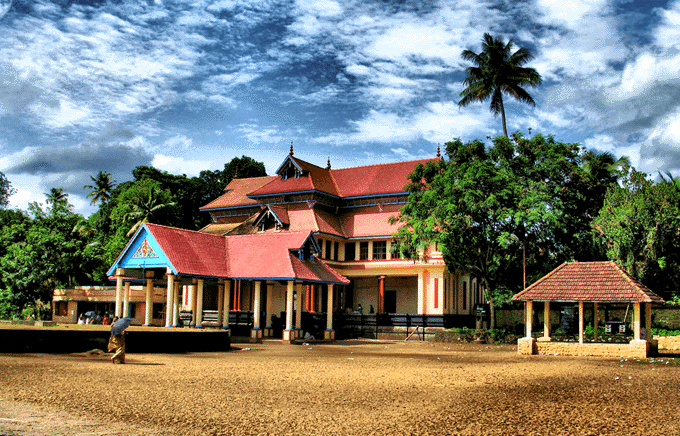
|
|
|
|
BY: SUN STAFF

Sunset at Camtapura Feb 23, CANADA (SUN) — A serial exploration of the holy sites visited by Lord Caitanya. Camtapura
Today we explore another of the tirthas that Lord Caitanya Mahaprabhu visited in Kerala during his pilgrimage through South India. Not to be confused with Kamtapura, home of the ancient Koch kingdom in West Bengal, Camtapura is a village at the southern tip of Kerala state, approximately 37 kilometers inland from the coast and 5 kilometers south of Kuttoor. In the summary of Sri Caitanya-caritamrta Madhya Lila 9, we find mention of Camtapura: Madhya 9 Summary "On the hill known as Mahendra-saila, the Lord saw Parasurama. Then the Lord went to Setubandha and took His bath at Dhanus-tirtha. He also visited Ramesvara, where He collected some papers connected with Sitadevi, whose illusory form was kidnapped by Ravana. The Lord next visited the places known as Pandya-desa, Tamraparni, Naya-tripadi, Ciyadatala, Tila-kanci, Gajendra-moksana, Panagadi, Camtapura, Sri Vaikuntha, Malaya-parvata and Kanya-kumari. The Lord then met the Bhattatharis at Mallara-desa and saved Kala Krsnadasa from their clutches." Later in Madhya Lila 9 we find further details on the Lord's visit to Camtapura: Madhya 9.222
"Later the Lord went to Camtapura, where He saw the Deities of Lord Ramacandra and Laksmana. He then went to Sri Vaikuntha and saw the temple of Lord Visnu there. PURPORT

Pamba River near Chengannur Before moving on with a discussion of Camtapura-tirtha and the local environs, we would like to make a point relative to the revisions made to Srila Prabhupada's books. Unfortunately, the Caitanya-caritamrta references to Camtapura serve as a good example of the problems stemming from these BBT revisions. The Madhya 9.222 verse quoted above is taken from the BBT's revised edition of Caitanya-caritamrta. In his purport, Srila Prabhupada states that Camtapura (or Chengannur) is located in the state of Kerala. When we look at the same verse in the original edition of Madhya Lila, however, we find the following: "Camtapura is sometimes called Cenganura and is located in the state of Tribankura. A temple of Lord Ramacandra and Laksmana is located there. Sri Vaikuntha-about four miles north of Alwar Tirunagarai and sixteen miles southeast of Tirunelveli-is situated on the bank of the Tamraparni River." No less than three important revisions have been made to Srila Prabhupada's purport. 'Tribankura' has been changed to 'Kerala', and the spelling of two place names have been changed: 'Cenganura' is changed to 'Chengannur', and 'Alwar' is changed to 'Alvar'. Those who have been following this Feature series on Lord Caitanya's tirtha-yatra will no doubt agree that one of the emerging themes has been the challenges presented by the changing of place names over time. Sastra generally refers to ancient place names, sometimes making it difficult to find these places on modern maps. Clearly, we can access a much deeper vein of information about a place if we know both the historical and modern place names. Why, then, do the BBT editors feel it necessary to modernize Srila Prabhupada's purports? In the case of Madhya 9.222, the editors may have thought it prudent to change 'Tribankura' to 'Kerala' because Kerala State is not commonly known as Tribankura State. Or perhaps it was because in the following verse, Srila Prabhupada refers to Kerala, albeit in a different context, and not specific to the location of Camtapura: Madhya 9.223 Purport (Original and Revised Editions) "The range of mountains in South India beginning at Kerala and extending to Cape Comorin is called Malaya-parvata." But we do not have to look far to see the importance of Srila Prabhupada's original reference to Tribankura. Following are the original and revised editions of Madhya 9.198: Madhya 9.198 (Original Edition) PURPORT Madhya 9.198 (Revised Edition) PURPORT In this case, we find that the name 'Tribankura' has not been edited out of the revised edition of Madhya Lila. (Instead, we find an appalling number of other changes.) The point is that the place name 'Tribankura' is given by Srila Prabhupada in his purport to Madhya 9.198 to describe a territory, not the state of Kerala. There is a vast difference between the two. By searching for the term 'Tribankura' in either the Vedabase or on Google, we can see that Tribankura is a very obscure place name. So what reason is there for the editors to change it? Future researchers who rely solely on the revised edition of Caitanya-caritamrta will not have the opportunity of knowing that Srila Prabhupada described Camtapura as being located in the state of Tribankura. Unless the BBT editors have ample proof that at no time in history was the region of Tribankura ever considered 'a state', perhaps of some ancient kingdom, we are left to wonder why they made such a change. But proof or no proof, we wish to rely on Srila Prabhupada's original statement about Tribankura, as it is.

Western Ghats near Chengannur Chengannur Tirtha Camtapura, the place known today as Chengannur, is a town in the Alappuzha district of Kerala, as was the tirtha we explored in yesterday's segment, Ciyadatala. Chengannur (also spelled Chenganoor, Chenganur, Chengannoor, or Chenkunrur) is located in the far eastern part of Alappuzha district. The nearest towns are Pandalam to the south, Thiruvalla to the north, Mavelikkara to the west, and Aranmula and Pathanamthitta to the east. Nammalvar described Chengannur as a town where the smoke emanating from Vedic ritual yagnas fills the sky, and as a place surrounded by rich lush vegetation (of bananas and coconuts). The name is said to have derived from 'Chennu Ninne Uru', which means "the place where they stopped", referring to a pastime wherein a sage is said to have gotten Shiva and Parvati to stop and give him darshan. Yuddhishtra is said to have offered prayers to Vishnu here, seeking pardon for his acts on the battlefield, having uttered the words, ashwattaama hatah kunjaraha in an attempt to deceive Drona and lead him into a defenseless state in which Arjuna could bring Drona's life to an end. Although we unfortunately could not identify the temple where Lord Caitanya visited the Deities of Lord Ramacandra and Laksman, there are many ancient temples in the area of Camtapura. The most famous is located in the village of Sabarimala, named after the great devotee Shabari, who did severe penance in order to meet Lord Rama. Sabarimala is a renowned pilgrim centre atop the hills of the Western Ghats, and the presiding deity of that temple is Lord Ayyappa.

Chengannur Mahadeva Kshetram Tiruchenkunroor temple, one of the 108 Divya Deshams (Visnu temples sung by the Azvars), is one of five ancient shrines in the Chengannur region associated with the Mahabharat. Also famous is the ancient Shiva temple, Chengannur Mahadeva Kshetram. It is one of the 51 Shakti Peethas, where thousands come for darshan of Goddess Parvati. Nearby is the Pandavan Para, a rock formation where the Pandavas stayed during their vanvaas. While on their pilgrimage, the Pandavas built Mahavisnu temples in various places in Kerala, along the banks of the holy River Pamba. Yudhishtira installed Visnu at Thirichittattu, less than 2 km north of Chengannur. Bhima build a Visnu temple at Thripuliyoor; Arjuna built the Krishna Parthasaradhy Temple at Thiruarunmula; Nakula built a Visnu temple at Thiruvanvandoor, and Sahadeva built one at Thirikudithanam. The Pamba River is the third longest river in Kerala, and is considered to be Dakshina Ganga. The Pamba originates at Pulachimalai hill, very near to Chengannur, and flows towards the coast, merging with the waters of Thottapally (Vembanad) Lake just before arriving at the sea.
| |